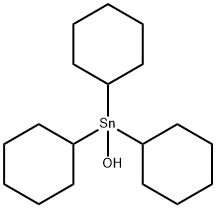Other grades of this product :
| Cyhexatin Basic information |
| Cyhexatin Chemical Properties |
| Melting point | 195-198°C | | Boiling point | 426.1±28.0 °C(Predicted) | | vapor pressure | 3×10-7 Pa (20 °C) | | Fp | >100 °C | | storage temp. | 0-6°C | | Water Solubility | <1 mg l-1(25 °C) | | pka | 6.76±0.70(Predicted) | | form | solid | | Hydrolytic Sensitivity | 4: no reaction with water under neutral conditions | | Merck | 13,2789 | | CAS DataBase Reference | 13121-70-5(CAS DataBase Reference) | | EPA Substance Registry System | Cyhexatin (13121-70-5) |
| Cyhexatin Usage And Synthesis |
| Chemical Properties | Cyhexatin is a colorless to white, nearly odor-
less, crystalline powder. | | Uses | Cyhexatin is a derivative of tricyclohexyltin and an effective acaricide used in the control of spider mites. | | Uses | Acaricide. | | Uses | Cyhexatin is used to control the motile stages of phytophagous
mites on pome and stone fruit, vines, hops, cotton, vegetables and
ornament ah. | | General Description | Technical Cyhexatin is a nearly odorless white crystalline powder that has no true melting point but degrades to bis(tricyclohexyl)tin oxide at 121 to 131°C which decomposes at 228°C; a melting point of 195-198°C is also reported. Very insoluble in water (less than 1 mg/L at 25°C), but wettable by water. Soluble in some organic solvents (acetone 1.3 g/L; xylenes 3.6 g/L; carbon tetrachloride 28 g/L; dichloromethane 34 g/L). Used as an acaricide (an agent to kill plant-feeding mites) in almonds, walnuts, hops and some fruits. | | Reactivity Profile | Cyhexatin is incompatible with strong oxidizing agents. Soluble in some organic solvents (acetone 1.3 g/L; xylenes 3.6 g/L; carbon tetrachloride 28 g/L; dichloromethane 34 g/L). Stable in aqueous suspensions in neutral and alkaline pH (above pH 6), but reacts exothermically as a base in the presence of strong acids to form salts. Converts to dicyclohexyltin oxide and further to cyclohexylstannoic acid upon exposure to ultraviolet radiation. | | Safety Profile | Poison by ingestion,
inhalation, and intraperitoneal routes.
Moderately toxic by skin contact.
Experimental reproductive effects. When
heated to decomposition it emits acrid
smoke and irritating fumes. See also TIN
COMPOUNDS. | | Potential Exposure | Used as an agricultural chemical and
pesticide. A potential danger to those involved in the manu-
facture, formulation, and application of this acaricide
(miticide). | | Metabolic pathway | There is little published information of the degradation and metabolism
of cyhexatin. However, useful information on the fate of cyhexatin in a
water/sediment system can be deduced from published data on
azoc yclotin. | | Shipping | UN2786 Organotin pesticides, solid, toxic,
Hazard Class: 6.1; Labels: 6.1-Poisonous material. UN2811
Toxic solids, organic, n.o.s., Hazard Class: 6.1; Labels: 6.1-
Poisonous materials, Technical Name Required. | | Degradation | Cyhexatin is stable to hydrolysis at temperatures up to 100 °C from
slightly acid (pH 6) to alkaline conditions (PM). | | Incompatibilities | Incompatible with strong oxidizers. May
react exothermically as base in the Incompatible with
strong oxidizers. May react exothermically as base in the
Incompatible with strong oxidizers. Reacts exothermically
as base in the presence of strong acids, forming salts. Keep away from ultraviolet radiation which may cause conver-
sion to dicyclohexyltin oxide and further to cyclohexylstan-
noic acid
. |
| Cyhexatin Preparation Products And Raw materials |
|
